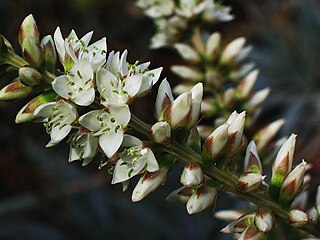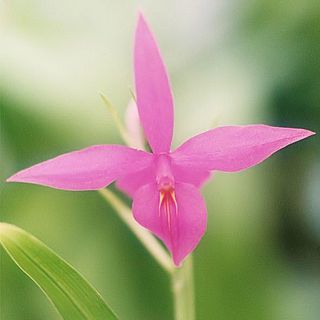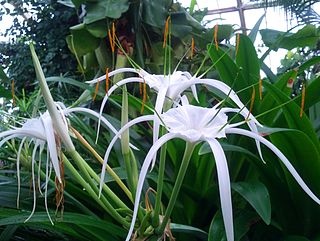
Melampodium is a genus of flowering plants in the sunflower family.

Tigridia, is a genus of bulbous or cormous flowering plants belonging to the family Iridaceae. With common names including peacock flowers, tiger-flowers or shell flowers, they have large showy flowers; and one species, Tigridia pavonia, is often cultivated for this. The approximately 60 species in this family grow in the Americas, from Mexico down to Chile.

Hechtia is a genus of plants in the family Bromeliaceae, and is the sole genus of the subfamily Hechtioideae, containing 75 species. Its species are native to Mexico, Central America, and Texas.

Barkeria, abbreviated Bark in horticultural trade, is a genus of orchids. It consists of about 17 currently recognized species native to Mexico and Central America. This genus was once considered part of Epidendrum. Type species is Barkeria elegans; this is now considered a synonym of B. uniflora yet retains its status as type per ICN.

Hymenocallis (US) or (UK) is a genus of flowering plants in the amaryllis family native to the Americas.

Trixis is a genus of shrubs in the family Asteraceae, native to North and South America including the West Indies.

Pitcairnia is a genus of plants in the family Bromeliaceae, subfamily Pitcairnioideae. It was named for William Pitcairn, Scottish physician and gardener (1711–1791). The genus Pitcairnia ranks as the second most prolific of the bromeliad family. They are most abundant in Colombia, Peru and Brazil, but can also be found in areas from Cuba and Mexico south to Argentina. One species, Pitcairnia feliciana, is found in tropical West Africa and is the only member of the family Bromeliaceae not native to the Americas.

Gonolobus is a genus of plant in family Apocynaceae, first described in 1803. It is native to South America, Central America, Mexico, the West Indies, and the southern United States.

Jarilla is a genus in the family Caricaceae of Brassicales.

MVS Radio are a group of four international Spanish-language radio networks owned by the mass media conglomerate MVS Comunicaciones. The group of radio networks consists of Exa FM, La Mejor, Globo and MVS Noticias and are broadcast in a various Latin American countries including Argentina, Costa Rica, Dominican Republic, Ecuador, El Salvador, Guatemala, Honduras, Mexico and the United States.

Hofmeisteria is a genus of Mexican flowering plants in the family Asteraceae.

Tridax is a genus of flowering plants in the family Asteraceae.
Desmanthodium is a genus of flowering plants in the family Asteraceae.

Hymenostephium is a genus of flowering plants in the family Asteraceae. It includes herbs and slender shrubs that occur from Mexico through to Venezuela and north-western Argentina.
Otopappus is a genus of flowering plants in the tribe Heliantheae within the family Asteraceae, primarily Mesoamerican but with one species from Jamaica.

Perymenium is a genus of South American and Mesoamerican plants in the tribe Heliantheae within the family Asteraceae.

Deiregyne is a genus of flowering plants from the orchid family, Orchidaceae, native to Mexico, Guatemala and Honduras.

Crusea is a genus of angiosperms in the family Rubiaceae. The genus is found in the south-western United States, Mexico, and Central America. A few species are naturalized in Cuba and Puerto Rico.
Each of the 31 states of Mexico and Mexico City has a separate coat of arms. Each Mexican state flag contains the respective state arms, typically on a white background.
















